Picto Diary - 20 January 2016 - Darjeeling
The Margaret Taylor Dance Troupe spent the day in Darjeeling, city name of which also defines the 87 tea estates surrounding the area. Darjeeling tea is known as the champagne of teas.
I was in Darjeeling riding a Royal Enfield Bullet motorcycle in 2009. Our group, then, didn't spend any time in the city. We had lunch and rode on to Bhutan. I was looking forward to getting a closer look this time.
Tomorrow we'll look at Glenburn's tea operation.
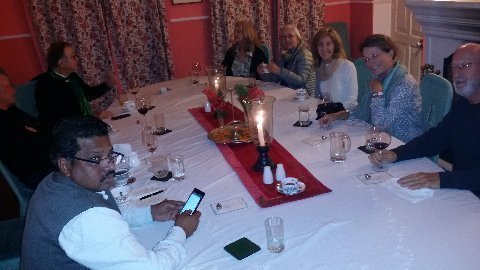
Above: Members of the Margaret Taylor Dance Troupe in India dine at Glenburn Tea Estate. Glenburn Tea Estate, Darjeeling, West Bengal, India. 19 January 2016 (last night).
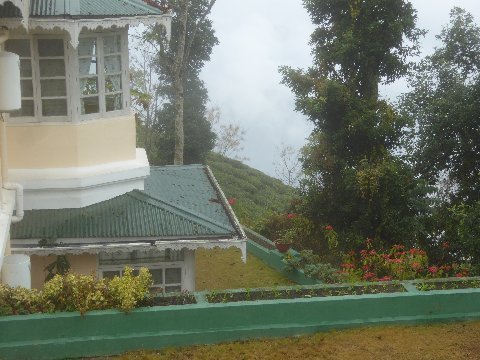
Above: Glenburn Tea Estate. West Bengal, India. 20 January 2016.
Early morning image shows tea plants - the famed Darjeeling tea - behind one of the estate's buildings.
Beyond fog. Doesn't look hopeful to see the visible when clear Himalayan peaks today.
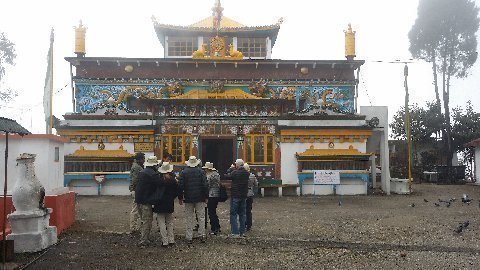
Above: Members of the Margaret Taylor Dance Troupe listen to guide Naresh talk about Yiga Choeling Buddist Monestary, established 1850. Ghoom, West Bengal, India. 20 January 2016.
Its cold! 39 degrees with a bit of wind. Occasionally, but rarely, it snows and freezes at this level... and that ends the tea crop.
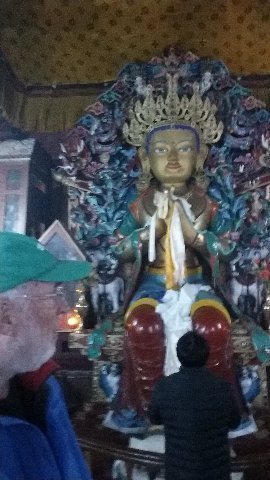
Above: The Bishop contemplates the Buddha at Yiga Choeling Buddhist Monastery, established in 1850. Ghoom, West Bengal, India. 20 January 2016.
The Bishop has now completed his January 2016 pilgrimage.. that of visiting a temple in India of each of the four religions founded in India: Hinduism, Sikhism, Jainism, and Buddhism.
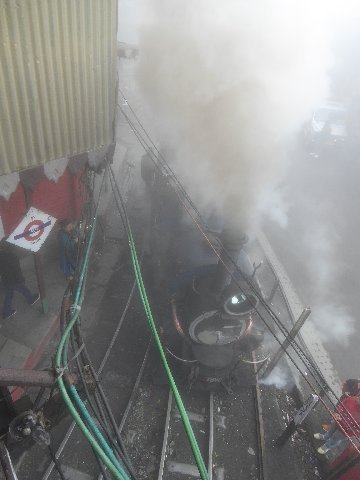
Above: Locomotive from Darjeeling Hill Railway. Darjeeling, West Bengal, India. 20 January 2016.
Huff puff. Smoke from the chugging engine engulfed me, standing on a bridge above, seconds after I captured this image.
There are 70 locomotives existing for this vintage railway, first built in the mid 19th century to ferry tea production out of the Himalayan foothills to Siliguri in the northern West Bengal low lands. 14 of the locomotives are operative and seven of them are in excellent condition. The railway is now run as a tourist attraction between Ghoom and Darjeeling. It was designated a UNESCO World Heritage Site in 2007.
Note the green hoses in the image. They are all over the city. They make up a make-shift, jury rigged water supply conduit supplement for an overloaded city water system, adequate for 50 years ago when Darjeeling's population was a third of what it is today - 130 thousand.
Darjeeling water is only available for two hours a day. Most homes have large plastic tanks that are filled when the water is on enabling a constant supply during the day.
Perhaps Jerry Brown should take a look at Darjeeling's resourcefulness in solving its water problems?
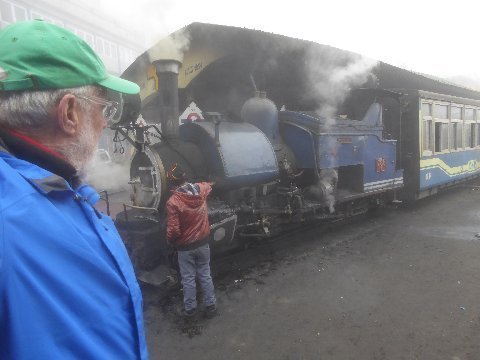
Above: Bishop examines locomotive of Darjeeling Hill Railway as railway employee pours oil, out of a used water bottle, on the works. Darjeeling Hill Railway, Darjeeling, West Bengal, India. 20 January 2016.
The control around the train at Ghoom station was non existent enabling us to get right up close to see the engine workings. I enjoyed looking... but, this experience would have been a gear-head's delight.
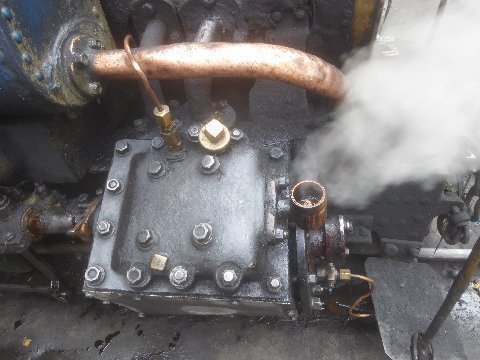
Above: Antique locomotive works. Darjeeling Hill Railway, Darjeeling, West Bengal, India. 20 January 2016.
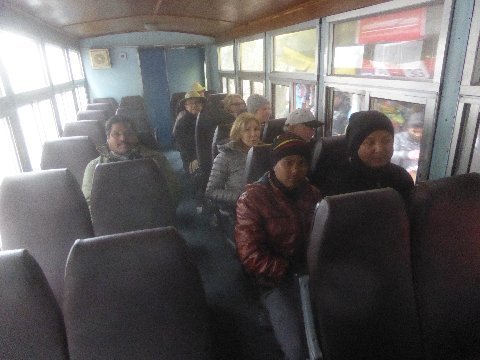
Above: Passenger car and passengers. Darjeeling Hill Railway, Darjeeling, West Bengal, India. 20 January 2016
Members of the Margaret Taylor Dance Troupe on rail car. Two railroad crew sit at the front of the car. The brakeman, turning a large wheel, is sitting in front, just out of the image.

Above: The Bishop and Chef Kailash Barik, Senior Sous Chef, Lunch. Mayfair Hotel. Darjeeling, West Bengal, India. 20 January 2016.
The food - Chef Kailash did an excellent job - kept coming and coming. I was full just after the first five appetizers... then the main courses started coming. He said he'd been working at Mayfair for 19 years.
He came out to say hello to our table. He proudly gave me his card. Is he looking for another job? Based on what we consumed at Mayfair: Hire.
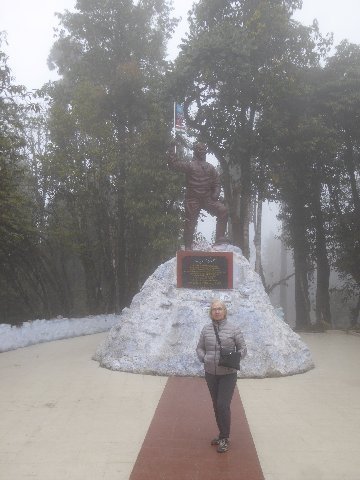
Above: TIMDT stands in front of statue of Tenzing Norgay, first person, along with Sir Edmund Hillary, to scale Everest in 1953. Himalayan Mountaineering Institute. Darjeeling, West Bengal, India. 20 January 2016.
Himalayan Mountaineering Institute is a spectacular museum.
Most fascinating to me was a thirty foot long, 15 foot wide diorama showing, in relief, the Himalayan range from the Kokhoram Mountains in Pakistan/Afghanistan to the eastern end of the range near the borders of Myanmar, China, and India.
Push this button and you could see, illuminated, the flow of the Brahmaputra River. Push that button and you could see lights track the flow of the Indus river far to the west. Of course, you could pinpoint the tallest of the Himalayan peaks using the diorama push buttons. The Tibetan Plateau could be seen on the diorama behind the range.
By looking at the diorama exhibit you could get a real sense of the continental collision of the sub continent with the main Asian continent which formed the Himalayan range only 10 million years ago.
Norgay's remains were cremated near this statue after his death in 1986. A cremation memorial marks that spot.
Darjeeling was a major hang out place for mountaineers. After his climb, and enjoying his fame, Norgay spent a lot of time hanging out with fellow Sherpas and climbers at the museum in Darjeeling.
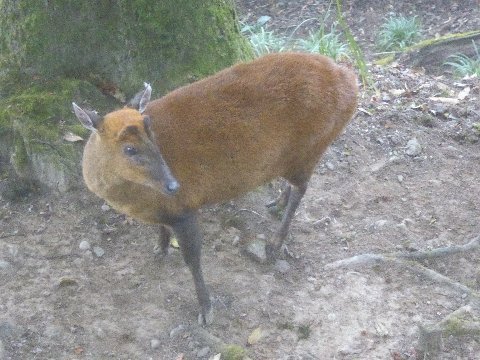
Above: Barking Deer. Padmaja Naidu. Himalayan Zoological Park. Darjeeling, India. 20 January 2016.
Himalayan animals I hadn't seen previously, zoo or otherwise.
Also known as muntjacs, barking deer are the oldest known deer, thought to have begun appearing 15 to 35 million years ago. Remains have been found in Miocene deposts in France, Germany and Poland.
Unlike most other species of deer, barking deer are fighters. They can be vicious protecting their territory using teeth and antlers to fight. Maybe that's one reason they have been around for so long.
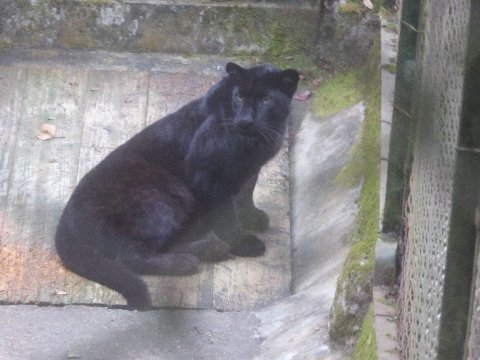
Above: Black Leopard. Padmaja Naidu. Himalayan Zoological Park. Darjeeling, India. 20 January 2016.
A black panther is typically a melanistic color variant of any of several species of larger cat. Melanism in leopards is conferred by a recessive gene.
The typical markings are hidden by the excess black pigment melanin giving an effect similar to that of printed silk.
The leopard inhabits densely forested area and is distributed in southwestern China, Myanmar, northeast India, and Nepal.
I felt bad seeing this magnificent animal caged. On the other hand, most animals in zoos have a 1/3 longer life span than those that live in the wild. And, its important for humans to be able to see these animals as it enhances understanding of wildlife and their role in the ecosystem.
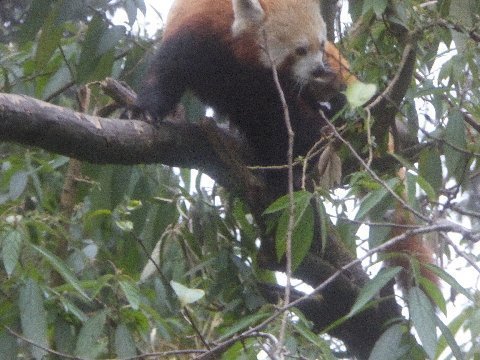
Above: Red Panda. Padmaja Naidu. Himalayan Zoological Park. Darjeeling, India. 20 January 2016.
Endangered animal residing in eastern Himalayas and southwestern China. Wild population estimated at less than 10 thousand mature individuals.
Solitary, nocturnal animal.
Threatened by habitat loss, fragmentation, poaching and inbreeding depression.
It is not closely related to the giant panda. Closest relations are weasels, skinks and raccoons.
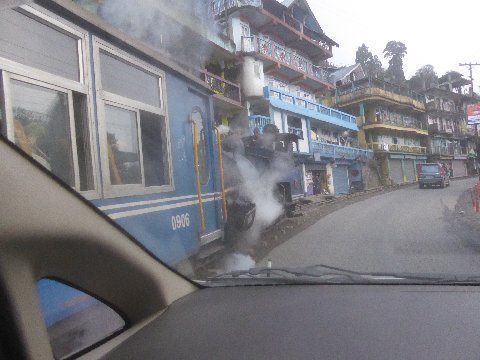
Above: Locomotive and passenger car of Darjeeling Hill Railway as it leaves Darjeeling for Ghoom. Darjeeling, West Bengal India. 20 January 2016.
Image captured from our car as we drive back to the Glenburn Tea Estate.
When I was in Darjeeling in 2009 I didn't see the train, but I remembered the tracks. The narrow gauge tracks cross the road diagonally two or three times as the road exists the city, direction Ghoom. A motorcyclist has to pay very careful attention situations like this as the front motorcycle wheel could slip going over the track and the bike and rider go down.
Funny... these tracks are my most vivid memory of my short experience in Darjeeling in 2009.